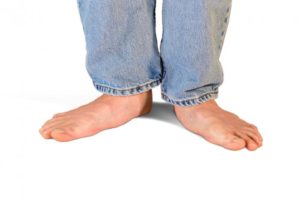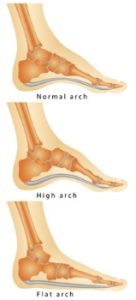Best walking shoes for flat feet – when you need extra arch support
According to a 2012 study, 8% of U.S. adults have flat feet. And for that crowd, it’s often hard to find a good pair of walking shoes. It’s also hard to find a good, reliable source of information on the subject. (Believe me, I had to do a lot of digging and researching to find the best walking shoes for flat feet.)
So we’ve pulled together some facts, as well as some recommendations on the best walking shoes for flat feet. Incidentally, many of the shoes on this list are also on our list of the best walking shoes for overweight people.

The human foot is ridiculously complex, biomechanically. There are 26 different bones, held together by 33 joints and over 100 muscles, tendons and ligaments.
The arches give spring to the step and distribute your weight across the feet and legs. The structures of the arches determine how a person walks. They need to be sturdy, strong and flexible to adapt to various surfaces and stresses.
Flat feet, also known as “fallen arches” pose a unique challenge…
Years of walking, running, and standing can weaken the posterior tibial tendon, which is the main support of the arch of the foot. Flat feet and over-pronation can lead to all sorts of problems, from the ankles to the knees to the hips and even into the back.

Interestingly, all babies have flat feet – with no visible arch at all. They actually do have an anatomical arch, but it is filled with fat until later in development when an arch gradually appears.
According to the Institute for Preventative Foot Health flat feet and fallen arches are closely related to overpronation, which is an excessive inward rolling of the foot during walking and/or running.
The usual way to determine if a person truly has flat feet (as opposed to simply being an overpronator) is to observe the arches in both seated and standing positions. In the person with flat feet, no arch will be observable in either the seated or the standing position. In a person who overpronates, the arch will be at least slightly visible in the seated or non-weight-bearing position, even though it may not be observable while he or she is standing.

A flat foot does not absorb shock as well as a foot with a normal arch. Therefore, it’s beneficial to find the best walking shoe for flat feet: One with extra energy-absorbing padding.
There are two types of flat feet: Rigid flat feet (RFF) and flexible flat feet (FFF).
An individual with RFF has no arch at any time – weigh or non-weight bearing. RFF is usually caused by some underlying pathology like when two or more of the seven tarsal (foot) bones fuse together. Trauma, infection, and neuromuscular and autoimmune disorders (such as Rheumatoid Arthritis) can also result in RFF.

If you have an arch that collapses when you stand you have Flexible Flat Feet (FFF). FFF is most often due to a weakening of the ligaments that connect the bones together, or due to muscle or tendon weakness. The tibialis posterior muscle provides much of its support for the medial longitudinal arch. Therefore, a problem with this muscle can result in FFF as well as other problems associated with tibialis posterior dysfunction – shin splints, plantar fasciitis, and injuries associated with overpronation.
If you have fallen arches, and you’re working to build the foot back up to its original high arch position, extra arch support in your shoes might not be a good idea. Many naturopathic doctors say orthotics only promote more weakness and dysfunction and DO NOT change the course of arch development. Essentially, they say you become so accustomed to having that extra support, it makes matters worse. Proponents of minimalistic shoes subscribe to this idea… better to walk barefoot, or nearly barefoot, so your feet muscles can get strengthen.
That’s debatable.
One thing’s for sure… If flat feet cause pain, supportive well-fitted shoes can help. So the best walking shoes for flat feet provide extra support for the heel, the arch, as well as the forefoot.
You need substantial, sturdy shoes that hold your foot firmly in place. Also, after-market insoles or orthotics may relieve pressure from the arch and reduce pain if the feet roll too far inwards.
Here’s our partial list of the best walking shoes for flat feet:
All of the shoes we list on this website can accommodate flat feet. However, those with the most cushioning and arch support are preferred for flat feet.
Very few shoes come with substantial arch supports built-in. So after-market insoles or orthotics commonly recommended for flat feet. Also, many people with flat feet find that walking shoes for wide feet work the best.
(For a complete list of the best walking shoes, please see our walking shoe buyer’s guide for men.
Walking shoe buyer’s guide for women.
ASICS Women’s GT-1000 5 Running Shoe
ASICS Impact Guidance System, Guidance Line, and Guidance Trusstic System focus on controlling and correcting overpronation issues in order to create a smoother and more enhanced glide from the heel to the toe. The result is a good sneaker for flat feet.
Saucony Grid Omni Walker Walking Shoes
Vionic Orthaheel walking shoes for flat feet
The removable Orthotic design has been influenced by a Podiatrist to offer better support and stability to your posture.Mid-sole area (between the outsole and upper) is incorporated with shock-absorbing molded EVA (ethylene-vinyl acetate) for superior impact resistance. This midsole is elevated up to 0.5” for an even level of alignment all through the heel-to-toe strike zone.
OOFOS Ooriginal Thong– Best Flip Flops for walking
As a general rule, we wouldn’t recommend flip flops for walking. However, if it’s summertime and your feet hurt, these are worth checking out.
Biomechanically engineered to alleviate the foot stress and soreness caused by your daily grind. Oofos are the best flip flops for walking.
Athletic shoe foams are designed to “rebound” and propel you forward. Revolutionary OOfoam does the opposite, absorbing 37% more shock with every step than traditional footwear foam. The soft, flexible OOfoam material enables your foot to articulate the way nature intended.
Unlike flip-flops, the OOFOS patented footbed is designed with tremendous arch support to take the pressure off of ankles, knees, and hips, as well as your lower back. OOFOS flex with both your foot and the ground.
Propet Stability Walker Shoes
- Internal and external heel counter gives high stability
- Lightweight molded EVA absorbs shocks and cushions your feet
- Rubber outsole with tread patterns gives improved traction
- Removable Orthotic insole is cushioned
- Padded collar and tongue for a customized fit
- Offered in varied colors and different width sizes
If any of the following conditions arise, medical advice should be sought:
- The fallen arches, or flat feet, have developed recently
- There is a pain in the feet, ankles or lower limbs
- Symptoms do not improve with supportive, well-fitted shoes
- One or both feet are becoming flatter
- The feet feel rigid or stiff, or heavy and unwieldy
Most qualified health care professionals can diagnose flat feet by watching the patient stand and walk, and by examining the feet.

